Photons & Fusion Newsletter - 2014
March
Photons & Fusion is a monthly review of science and technology at the National Ignition Facility & Photon Science Directorate. For more information, submit a question.
Plans to Increase NIF’s Shot Rate Capability Described
Planning, scheduling, and efficiency changes designed to increase NIF’s productivity were discussed by Acting NIF&PS Principal Associate Director Jeff Wisoff in Directorate All-Hands meetings on March 12.
Wisoff described the details and impact of a Congressionally-mandated 120-day study to find ways of increasing the NIF shot rate over three years at a constant annual funding level. A national team of NIF collaborators and sponsors led by NIF Director Jeff Atherton and Deputy for NIF Doug Larson has been “looking very deeply into and challenging assumptions about how we operate,” Wisoff said, and will be making organizational, engineering, scheduling, and experimental configuration recommendations to enhance NIF’s shot availability.
NIF’s shot rate already has increased to an average of five shots a week in the second quarter of Fiscal Year 2014, partly through the scheduling of “mini-campaigns” that minimize facility changes while optimizing data return (see the February NIF Status Update). By engaging the NIF user community as well as NIF’s sponsors in the effort, Wisoff said, the study will further the ultimate goal of transforming NIF into a world-class user facility.
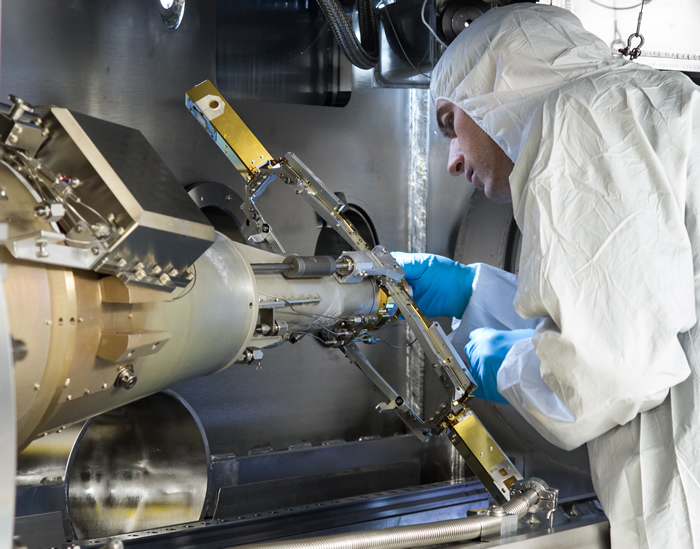 Senior Mechanical Engineer Kurt Boehm, along with diagnostics technicians Wayne Abreu and John Borgman (not in photo), installed and performed the initial checkout of a new shimless and integrated shroud assembly on an ignition target inserter and cryostat (ITIC) in the NIF cryogenic target positioner (CryoTARPOS). Part of NIF’s current effort to increase shot availability through operational efficiencies, the new design has reduced shroud installation and alignment time by half.
Senior Mechanical Engineer Kurt Boehm, along with diagnostics technicians Wayne Abreu and John Borgman (not in photo), installed and performed the initial checkout of a new shimless and integrated shroud assembly on an ignition target inserter and cryostat (ITIC) in the NIF cryogenic target positioner (CryoTARPOS). Part of NIF’s current effort to increase shot availability through operational efficiencies, the new design has reduced shroud installation and alignment time by half. HAPLS Diode Power Delivery System Components Demonstrated
The first demonstration of components of the short-pulse diode-pumped solid-state laser (DPSSL) system for the High Repetition-Rate Advanced Petawatt Laser System (HAPLS) has been conducted. HAPLS, which when complete will be the world’s highest average power petawatt laser system, is being designed, developed, assembled and tested at LLNL for delivery to the European ELI-Beamlines science facility in the Czech Republic.
A key component of a DPSSL is the diode power conditioning required to drive the 3.2 megawatts of diode light used to pump the gain media of the laser. The diodes consist of four arrays with each array having 45 laser diode tiles, which need to be driven at a pulse current of 500 amps for 300 microseconds at 10 cycles per second (10Hz). To deliver the required current to drive HAPLS’ 180 laser diode tiles, the HAPLS Power Conditioning Team developed an integrated system consisting of diode pulsers, a real-time control system, a crate to house the pulsers and controller, and low-loss cables to deliver the current pulses to the diode tiles.
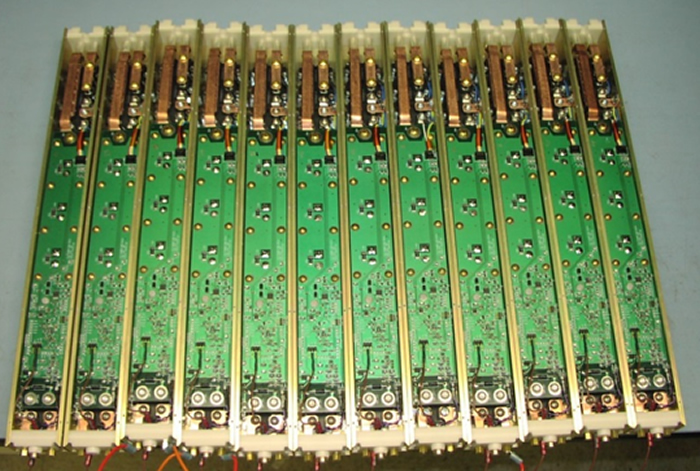 Twelve of the recently completed HAPLS diode pulser production models. Each pulser is capable of delivering 1,000-amp, 110-volt pulses at a repetition rate of 120Hz with a pulse width of 350 microseconds. Each pulser has a custom wave-shaping capability using an arbitrary waveform generator to compensate for parasitic losses and stray inductance.
Twelve of the recently completed HAPLS diode pulser production models. Each pulser is capable of delivering 1,000-amp, 110-volt pulses at a repetition rate of 120Hz with a pulse width of 350 microseconds. Each pulser has a custom wave-shaping capability using an arbitrary waveform generator to compensate for parasitic losses and stray inductance. The pulser crate is an aluminum structure about the size of a desktop computer which houses up to 45 pulsers. When fully populated with pulsers, the crate will be capable of delivering 45,000 amps of current at a 10-Hz rate to a pump diode array. For the demonstration, a crate with 12 pulsers was operated at full current and voltage, delivering 6,000 amps into resistive loads. The crate was then delivered to the HAPLS diode vendor to perform tests on the diode tiles that will be used in the HAPLS laser.
Study of Target Capsule Seed Crystals on Journal of Applied Physics Cover
The effects of phase change and self-heating on the formation of the DT cryogenic ice layer inside NIF target capsules were described by LLNL researchers in the cover article for the March 28 issue of the Journal of Applied Physics.
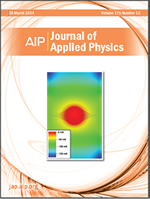 Image on the cover of the March 28 issue of the Journal of Applied Physics shows the computed temperature field inside a NIF target capsule.
Image on the cover of the March 28 issue of the Journal of Applied Physics shows the computed temperature field inside a NIF target capsule. For NIF ICF experiments, the solid DT layer must be smooth and uniformly thick. In-situ generation of single seed crystals is an important step in the growth of these high-quality hydrogen layers used for fusion research. The small size of the capsule shell, cryogenic temperatures, radioactive decay of tritium, and wholly confined geometry, however, present a challenging crystallization environment.
Describing a detailed calculation of the temperature profile for liquid hydrogen inside the hollow capsule, the researchers said that latent heat effects and byproducts of tritium beta decay (heat and helium-3) slowly alter the composition of the hydrogen vapor, influence the thermal environment inside the shell, and consequently dictate the location of the seed crystal.
The minimum temperature on the inner wall of the shell is initially at the midplane, but the accumulation of helium-3 in the vapor phase causes a secondary temperature minimum at the top of the shell. The results suggest that the seed continues to form at the point of lowest temperature on the inner surface of the shell and that this point changes as helium-3 accumulates in the vapor and the modified temperature profile encourages seed formation at the top of the shell. In addition to the system environment and self-heating, phase change effects due to latent heat and the sensitivity of vapor pressure to changes in temperature have a strong influence on the thermal profile of the system, the researchers said.
Lead author Salmaan Baxamusa was joined by LLNL colleagues John Field, Rebecca Dylla-Spears, Bernie Kozioziemski, Tayyab Suratwala, and Jim Sater.
Mitigating High-Fluence Laser Damage Precursors in Fused Silica Optics
The use of any optical material in a high-energy laser system such as NIF is limited at high fluences by laser-induced damage to optical surfaces. Unlike fractures, which are readily observed by scanning electron microscopy and even optical microscopy, high-fluence damage precursors have yet to be associated with a readily observable surface feature prior to damage initiation.
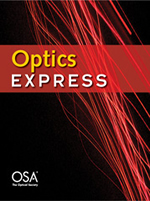
These “invisible” precursors present a significant barrier to the fabrication of ultraviolet optics for high-fluence applications. The Advanced Mitigation Process (AMP) uses an optimized hydrofluoric acid or a buffered oxide etch to remove both the polishing layer and fracture-induced electronic defect layer of silica optics (see photo). Even though optics that have undergone the AMP process exhibit a considerable increase in damage performance, a high density of laser surface damage precursors remains.
In an Optics Express article published online on March 5, LLNL researchers reported that a variety of nominally transparent materials in trace quantities can act as surface damage precursors. For example, even a very small volume of high-quality deionized water aerosolized onto and dried on the surface can introduce high-fluence damage precursors. Minimizing the presence of such precipitates during chemical processing steps such as cleaning, etching, and rinsing can reduce damage precursor density in silica at high fluence by more than 100 times, while shifting the fluence onset of observable damage upwards by about seven joules per square centimeter, the researchers said.
By working to exclude reagent and process contamination and to minimize precipitation during chemical processing operations, the researchers demonstrated the production of silica optics with extraordinarily low damage precursor densities. A better understanding of the complex chemistry and physics of cleaning, rinsing, and drying will likely lead to even further improvements in the damage performance of silica and potentially other optical materials.
Lead author Jeffrey Bude was joined by LLNL colleagues Phil Miller, Salmaan Baxamusa, Nan Shen, Ted Laurence, Rusty Steele, Tayyab Suratwala, Lana Wong, Wren Carr, David Cross, and Marcus Monticelli.
 Optics processing technician Scott Whitehouse loads the first full-sized NIF optic into the recently installed Advanced Mitigation Process station in the Bldg. 391 Optics Processing Facility. This station has three serial process tanks for surface mitigation of new and refurbished grating debris shields and wedge focus lenses, and features increased automation. It will accommodate more complex optics treatment processes (designated as the “AMP3” process) that, along with improved finishing processes described in the Optics Express paper, could improve the laser damage threshold of fused silica optics.
Optics processing technician Scott Whitehouse loads the first full-sized NIF optic into the recently installed Advanced Mitigation Process station in the Bldg. 391 Optics Processing Facility. This station has three serial process tanks for surface mitigation of new and refurbished grating debris shields and wedge focus lenses, and features increased automation. It will accommodate more complex optics treatment processes (designated as the “AMP3” process) that, along with improved finishing processes described in the Optics Express paper, could improve the laser damage threshold of fused silica optics. Novel NIF X-ray Drive Measurements Reported in Physical Review Letters
“ViewFactor” experiments conducted on NIF last year have revealed the source of a discrepancy between simulations and measured ablator implosion velocity, LLNL researchers and collaborators reported in a Physical Review Letters paper published online on March 13.
The experiments used ignition-scale cryogenic hohlraums with one end cut off, exposing the hohlraum interior and far laser entrance hole (LEH) directly to views from x-ray spectrometer and x-ray imaging diagnostics. The technique allowed the first direct measure of the hohlraum x-ray drive from the viewpoint of the target capsule, as opposed to the usual measurement of the drive through the LEH, from which the capsule drive is inferred.
The experiments were designed to create a plasma environment as close as possible to the ignition target while allowing for a more complete view of the hohlraum interior. The capsule was replaced by a thin plastic shell to reproduce the plasma environment of an ignition hohlraum while remaining transparent to the x-ray diagnostics.
The researchers said the experiments measured lower capsule drive than the LEH-inferred drive, consistent with slower implosion speeds. “The ViewFactor data demonstrate that the cause of the reduced implosion speed is a deficit in x-ray drive relative to simulations,” they said. “The drive deficit of 15 to 25 percent represents almost all of the discrepancy between simulations and the observed implosion hydrodynamics. This finding indicates shortcomings in the current modeling of the laser-produced x-ray drive, which was based mostly on measurements of hohlraums and gold spheres in vacuum. The results…indicate that it is the model for x-ray production in gas-filled hohlraums and not ablation physics that must be improved to gain predictive capability for indirect-drive ignition experiments.”
Lead author Stephan MacLaren was joined by LLNL colleagues and collaborators from the UK’s Atomic Weapons Establishment.
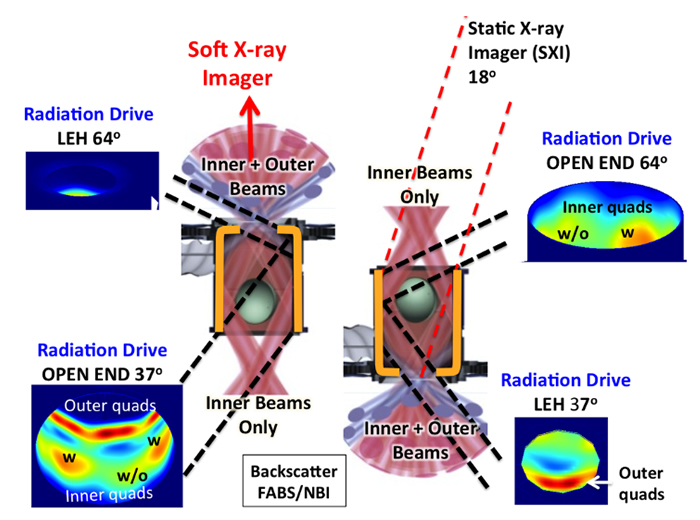 Experimental configuration for the ViewFactor experiments, showing the truncated hohlraum and its two orientations, open end down (left) and open end up. The views from the four radiation drive measurements also are shown.
Experimental configuration for the ViewFactor experiments, showing the truncated hohlraum and its two orientations, open end down (left) and open end up. The views from the four radiation drive measurements also are shown. Study of Laser-induced Damage in DKDP Crystals Reported in Journal of Applied Physics
New insights into the initial material transformations leading to laser-induced damage in the bulk of deuterated potassium dihydrogen phosphate (DKDP) nonlinear crystals have been obtained by Laboratory researchers and a colleague through a study of the damage processes as a function of the laser photon energy. Laser damage transforms a nominally transparent non-absorbing material into warm dense matter (WDM), an  NIF’s large, rapid-growth potassium dihydrogen phosphate (KDP) and deuterated KDP (DKDP) crystals are used in optical switches for polarization rotation and in the final optics assemblies for frequency conversion. intermediate state between the solid state and dense plasma characterized by temperatures ranging from a few tenths to tens of electron volts at densities close to the solid one. WDM represents a laboratory analogue of astrophysical conditions found in the core of giant planets or induced during high energy density conditions such as during ICF experiments.
NIF’s large, rapid-growth potassium dihydrogen phosphate (KDP) and deuterated KDP (DKDP) crystals are used in optical switches for polarization rotation and in the final optics assemblies for frequency conversion. intermediate state between the solid state and dense plasma characterized by temperatures ranging from a few tenths to tens of electron volts at densities close to the solid one. WDM represents a laboratory analogue of astrophysical conditions found in the core of giant planets or induced during high energy density conditions such as during ICF experiments.
In a Journal of Applied Physics paper published online on March 11, LLNL’s Michael Feit and Stavros Demos, along with collaborator Guillaume Duchateau of the Center for Intense Lasers and Applications in Talence, France, reported on experiments and modeling of nanosecond bulk laser damage to deuterated potassium dihydrogen phosphate (DKDP) crystals.
They found that the damage threshold as a function of the laser parameters is strongly influenced by the optical properties of the formed warm solid density plasma, the transient phase of the material during which most of the laser energy is absorbed. Consequently the system developed during the study “is well adapted to the study of the transition of materials to the warm dense matter state, while avoiding the complicating influences of hydrodynamics and heat diffusion,” they said. “This can enable well-controlled experiments and understanding of the material properties during the formation and evolution of warm dense matter.”
Laser-Driven Extreme-Compression Experiments Described at APS Meeting
LLNL researchers discussed experiments aimed at determining the response of a variety of materials to extreme levels of pressure and compression during a March 3-7 meeting of the American Physical Society (APS).
During a session on laser-driven extreme compression science, Jon Eggert described a variety of new techniques and facilities that are shattering previous experimental limitations on extreme-compression science, such as static pressures of more than six megabars (one megabar [Mbar] is the pressure exerted by the water at the bottom of the 6.8-mile deep Mariana Trench, the deepest point in the ocean).
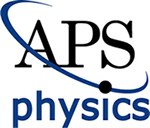
Other developments include equation of state (EOS) experiments on pulsed-power machines, picosecond-resolved x-ray diffraction on free-electron lasers, and many new experiments on high-energy lasers such as NIF, the Janus Laser at LLNL’s Jupiter Laser Facility, and the OMEGA Laser System at the University of Rochester. “Our goals, using high-energy lasers, have been to push the limits of high pressure accessible to measurement and to bridge the gap between static- and dynamic-compression experiments,” Eggert said.
Eggert described laser techniques for both shock- and ramp-compression experiments (ramp, or gradual, compression keeps sample temperatures low and allows the study of extreme-density-compressed-matter). He also discussed the results of recent extreme-compression experiments that provide experimental access for the first time to the interior states of giant planets and novel structures that theory predicts will exist at extreme compression. The experiments have shown the ability to compress solid iron and tantalum to nearly 10 Mbar and carbon to 50 Mbar.
“As the National Ignition Facility transitions to a laser user facility for basic and applied science,” Eggert said, “the unprecedented quality and variety of diagnostics available, coupled with exquisite pulse-shaping predictability and control, make the NIF a premier facility for extreme-compression experiments.”
Also presenting invited papers at the APS meeting were LLNL’s Amy Lazicki, who described new results of x-ray diffraction experiments on NIF and OMEGA on dynamically-compressed tin, tantalum, magnesium oxide, lead, and diamond—work that reveals new structural transitions at previously inaccessible pressures; and Dayne Fratanduono, who described near-absolute equation-of-state measurements of plastic at six megabars of pressure on the OMEGA laser using velocimetry and radiography.
Eggert and Lazicki also discussed their work a news conference and Webcast on March 5 on the topic, “The Now and Future NIF.”




